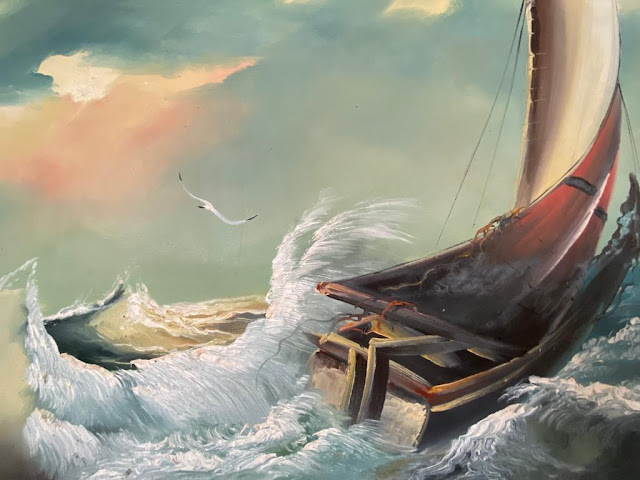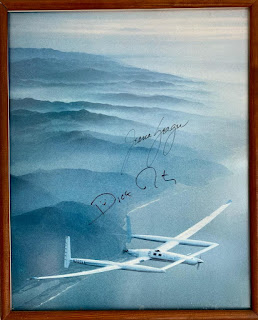Why Do I Fly?
When I was 10 years old I took my first steps into the air. It was when I first soloed. My brother and I and a friend decided we wanted to build an airplane. It was a beautiful airplane, a design of three, genius, 10 year old boys. It was made of cardboard and two by fours. Probably weighed 100 pounds.
We hauled it to the top of the garage and secured it there with ropes lest it fly away on its own. Then we had to select a pilot. It was a single seat aircraft so there would be no passengers. It seemed the fairest way to select the pilot would be by “drawing straws.” I won the draw so was now both the Chief Engineer and the Test Pilot. It was an honor that almost killed me!
After much discussing the flight-plan, I picked up the plane...with the help of my crew, and jumped off the roof of the garage. My report upon reaching the ground in less than one second of near VERTICAL flight was that, “There was not enough air under the plane for it to fly.” We had to find a higher place to jump from.
Searching the neighborhood we found that in the “Gravel Pit” less than a mile away was a chalk cliff that was 30 feet high. “That should be enough air for it to fly.” I exclaimed. The pilot was to be the one of us with the most “stick time” which turned out to be me with one test flight already under my belt. What an honor!
But, as Chief Engineer, I was very concerned with safety so was insisting on a parachute in case I had to bail out. We built a parachute using a bed sheet and a frame made of fence lath. It was like a huge tablecloth with a wooden frame. There were four ropes from the corners to my belt loops and it sat atop my head like a Coolie hat. Now I was safe and could proceed with Test Flight #2.
We managed to get the whole set up to the Gravel Pit and on top of the cliff. Then after discussing the emergency procedure, “Drop the plane and let it fall away as I drifted slowly to the earth under the parachute” I prepared to jump off the cliff. I jumped and to everyone's surprise, I survived the inevitable crash, two by fours, sheet, cardboard and me. I didn't even get a scratch. But the plane was totaled and couldn't be repaired which probably saved my life...
Twenty years later with proper instruction from a pilot that had learned to fly from Orville Wright, I soloed for the second time, in a Piper J3 Cub. It was a thrill that far outweighed that first solo. The exhilaration of my real solo flight was only matched by the first time I “caught air” on a Wind Surfer. And the first time I had sex.The first plane I owned was a 1954 Cessna 170B with crosswind gear. I learned to fly it from that same pilot that soloed me, Morris Norwood. It was a fantastic plane that I could land and stop “before rolling off the numbers”.


My second plane was doomed from the start. A Piper 140 that I bought with a partner. I never got to pilot it. The day after my partner returned from Florida with the plane we took it to my daughter's college with Pat as the pilot and myself as co-pilot and Maria in the back seat. The next day Pat flew it to a nearby airport to get the radio checked out and on the return flight he managed to screw up the landing and destroy the plane while suffering some serious injuries. That was the end of #2.Number three was a 1947 Ercoupe. It was flush riveted, had an upgraded engine, controllable pitch propeller and was capable of 135 miles an hour cruise. Quite an accomplishment for an 85 HP Continental engine.
I spent many an enjoyable hour in the “Homesick Angel”. She could handle ANY crosswind landing and could get better than 20 miles to the gallon back when most cars couldn't do that good. A quarter of my logbook was with N111J in and out of little grass airfields that no one ever visited. The number, “November One One One Juliet” was one I selected from available numbers at the FAA. I wanted one that was easy to remember. Later I discovered that it had once been the number of a famous aviatrix plane. Beryl Markham, from Kenya, Africa, the first to cross the Atlantic Ocean flying westward, against the prevailing winds, had that number at one time.One day my sister came to visit. She is a white knuckle flier that will only fly after two Margaritas, maybe three... But I managed to convince her to go up with me without booze. We flew in a large circle around Austin TX only landing at grass strips in the boonies. After the flight I asked her if she enjoyed the flight in spite of her fear of flying. Her response was, “Yes, as soon as you landed it on grass, I knew you could land it anywhere.” It's a good thing that she didn't look at the fuel gauge as we were approaching home after flying for almost four hours. .
















